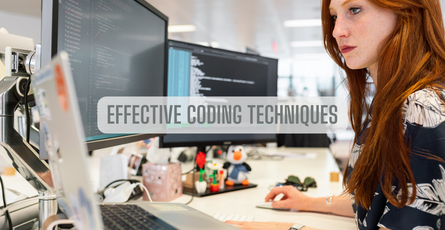Unlocking Efficiency: 10 Strategies for Pair Programming Collaboration

Understanding Pair Programming
In the dynamic landscape of software development, collaboration and efficiency are paramount. One methodology that has gained significant momentum for achieving these goals is Pair Programming. This collaborative technique involves two developers working together at a single workstation, with one assuming the role of the "driver" writing the code, and the other as the "observer" or "navigator" reviewing each line as it's written. In this guide, we'll explore the strategies, tools, and best practices that make pair programming a valuable asset for development teams.
What is Pair Programming?
Pair programming is more than just a coding technique; it's a collaborative approach aimed at producing high-quality code efficiently. The real-time interaction between developers fosters immediate problem-solving and knowledge transfer, leading to improved code quality.
Benefits of Pair Programming
- Code Quality: Immediate feedback and continuous review lead to cleaner and more efficient code.
- Knowledge Sharing: Team members learn from each other, promoting skill development.
- Reduced Bugs: The constant code review process reduces the likelihood of errors, resulting in more robust applications.
Pair Programming Strategies
Cross-Pollination Pairs
Unite developers from different teams or departments to foster cross-pollination of ideas. Witness how diverse perspectives and skill sets can lead to innovative solutions and a richer codebase.
Mob Programming Madness
Embrace the power of the mob! Mob programming involves the entire team working together on a single task. Discover how this strategy promotes collective ownership, knowledge sharing, and accelerated problem-solving.
Ping-Pong Pairing
Infuse an element of gamification into pair programming with the ping-pong pairing technique. Explore how developers take turns being the "driver" and "navigator," creating a dynamic and engaging coding experience.
Blindfolded Coding Challenges
Elevate the excitement by introducing blindfolded coding challenges. One developer writes the code while the other navigates, providing directions. This strategy enhances communication skills and promotes trust within the pair.
Inverted Roles
Flip the script by having the more junior developer take the lead as the "driver." Explore how this inversion of roles enhances learning opportunities, boosts confidence, and creates a more egalitarian coding environment.
Silent Synchronized Coding
Experience the power of non-verbal communication with silent synchronized coding. Developers collaborate without speaking, relying on shared understanding and intuition. Uncover how this strategy enhances focus, code readability, and teamwork.
Pair Rotation Marathons
Keep the energy flowing by implementing pair rotation marathons. Developers switch pairs regularly, ensuring a constant exchange of ideas and preventing stagnation. Witness how this strategy promotes adaptability and a dynamic team culture.
Algorithm Dueling
Introduce friendly competition with algorithm dueling. Developers pair up to solve coding challenges or implement algorithms, fostering a spirit of healthy rivalry that sparks creativity and skill development.
Extreme TDD Sessions
Take Test-Driven Development (TDD) to the extreme with focused TDD sessions. Explore how this strategy emphasizes writing tests first, guiding the coding process and ensuring a robust and well-tested codebase.
User-Centric Pairing
Center pair programming around the end-user. Developers work together to understand user stories, ensuring that the code reflects user needs and expectations. Witness how this strategy enhances empathy and user-focused development.
Pair Programming Tools Comparison for 2024
In the fast-paced world of software development, having the right tools is essential to facilitate seamless collaboration and enhance productivity. Here, we explore a selection of cutting-edge tools and technologies that empower developers in pair programming scenarios.
Visual Studio Code Live Share:
- Overview: Visual Studio Code Live Share is a real-time collaborative development tool that enables developers to share their coding sessions. It provides shared debugging, terminal access, and the ability to edit code together in real-time.
- Strengths:
- Versatility: Works with a variety of programming languages.
- Extensive Collaboration: Allows multiple developers to collaborate simultaneously.
- Built-in Chat: Integrated chat functionality for efficient communication.
Atom Teletype:
- Overview: Atom Teletype is a collaborative coding package for the Atom text editor. It enables developers to share their workspace with team members, facilitating real-time collaboration on projects.
- Strengths:
- Seamless Integration: Designed specifically for Atom, ensuring smooth integration.
- Instantaneous Sharing: Developers can instantly share their code with others.
- Version Control Integration: Works well with version control systems.
GitHub Copilot:
- Overview: GitHub Copilot, powered by OpenAI Codex, is an AI-driven code completion tool integrated into Visual Studio Code. It suggests entire lines or blocks of code based on natural language comments and existing code context.
- Strengths:
- AI-Powered Assistance: Provides context-aware code suggestions using machine learning.
- Speed and Efficiency: Accelerates coding by suggesting entire lines of code.
- Language Support: Supports a wide range of programming languages.
Role of GitHub Copilot
GitHub Copilot represents a paradigm shift in pair programming by leveraging artificial intelligence. Here's how you can seamlessly integrate GitHub Copilot into your pair programming sessions:
AI-Powered Code Assistance
Integration: GitHub Copilot seamlessly integrates into Visual Studio Code as a code completion tool.
Benefits: Leverages machine learning to understand code context and provides context-aware code suggestions, significantly speeding up the coding process.
Enhancing Productivity
Usage: Developers can use GitHub Copilot to generate code snippets, functions, or even entire methods based on natural language comments.
Benefits: Boosts productivity by automating repetitive coding tasks and reducing manual typing.
Continuous Learning
Impact: GitHub Copilot serves as a valuable learning tool, offering insights into coding best practices and patterns.
Benefits: Accelerates the learning curve for junior developers and introduces experienced developers to new approaches and techniques.
Overcoming Challenges
Pair programming offers numerous benefits, but it's not without challenges. Address common issues such as communication barriers and differences in coding styles. Emphasize the importance of clear communication, setting expectations, and periodic retrospectives to continuously improve the pair programming process.
- Clear Communication: Ensure open and transparent communication channels between the pair to avoid misunderstandings and streamline the development process.
- Setting Expectations: Clearly define roles, responsibilities, and project goals before initiating pair programming sessions to align expectations and minimize friction.
- Periodic Retrospectives: Schedule regular retrospectives to reflect on the pair programming experience, identify areas for improvement, and implement constructive feedback.
Conclusion
Pair programming stands as a powerful approach to software development, emphasizing collaboration, knowledge sharing, and code quality. By implementing the right strategies, choosing suitable tools, and addressing challenges head-on, development teams can unlock the full potential of pair programming, propelling their projects to new heights.
Whether you're a seasoned developer looking to enhance your workflow or a team leader seeking improved outcomes, embracing pair programming could be the key to unlocking greater efficiency and collaboration in your development process.



